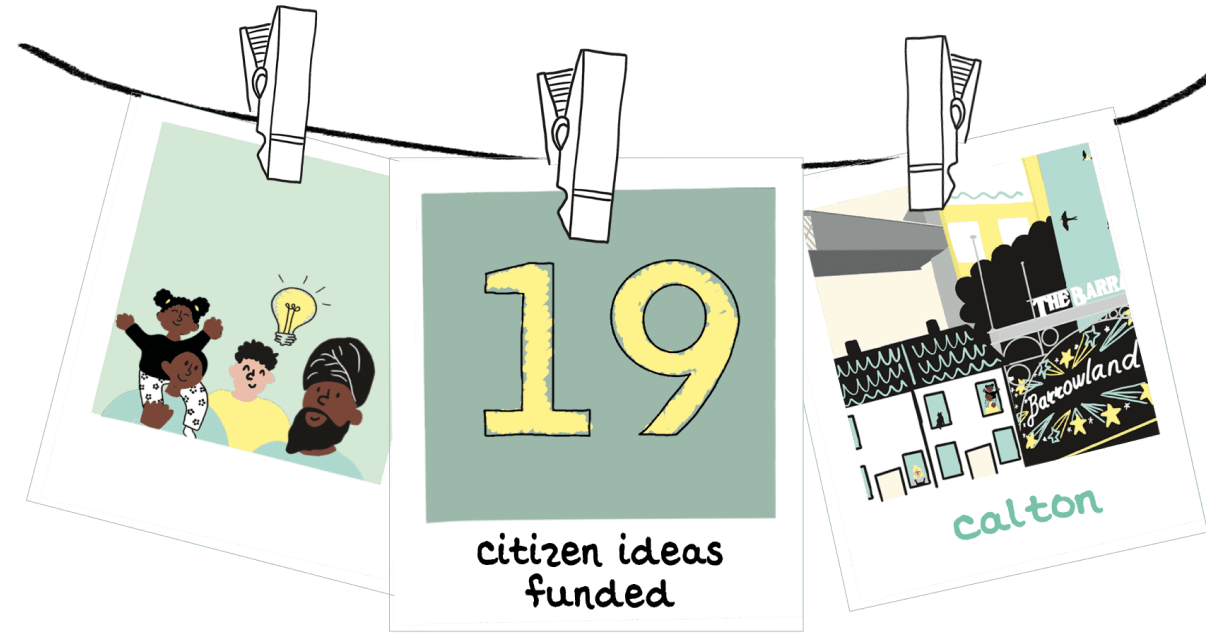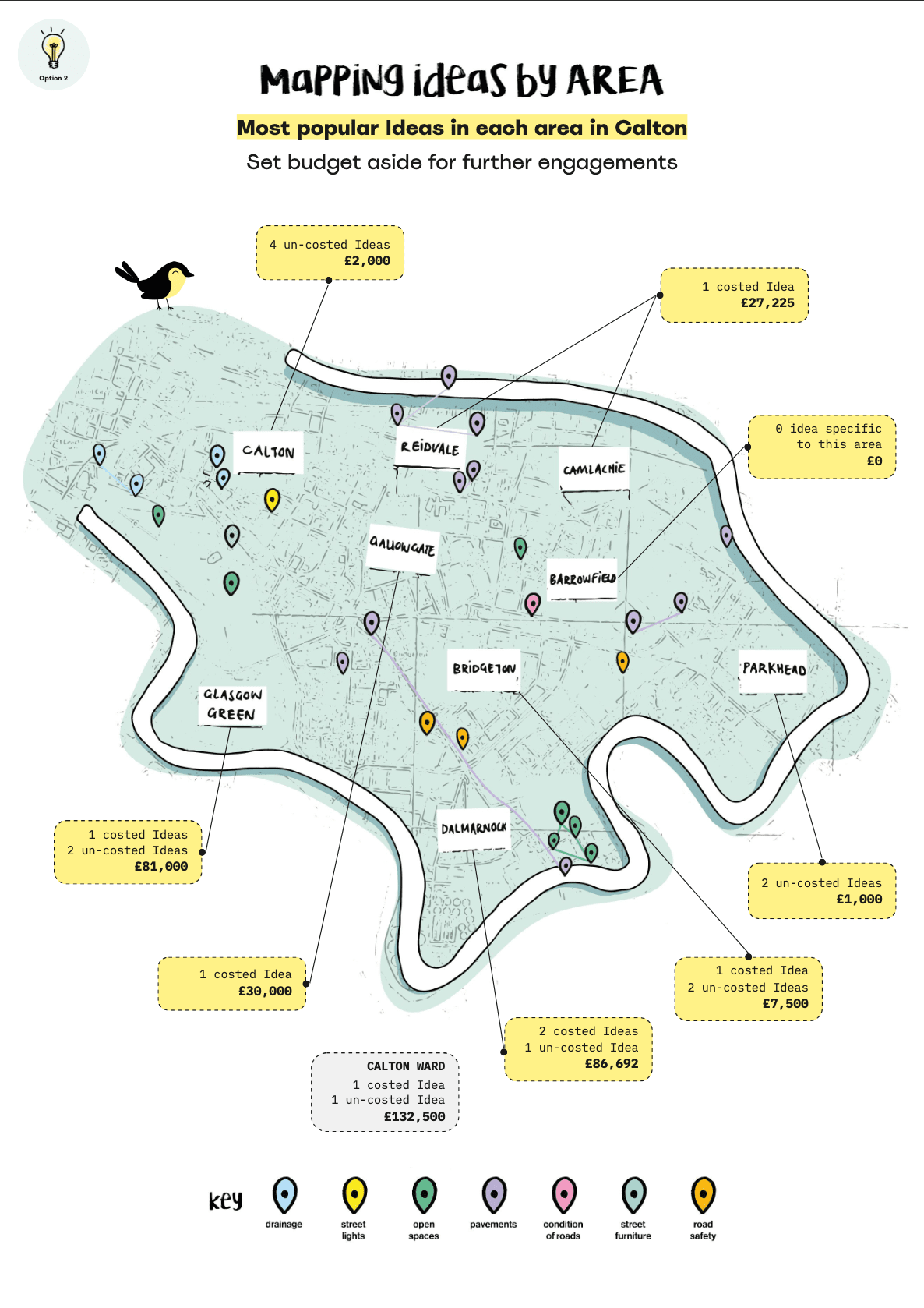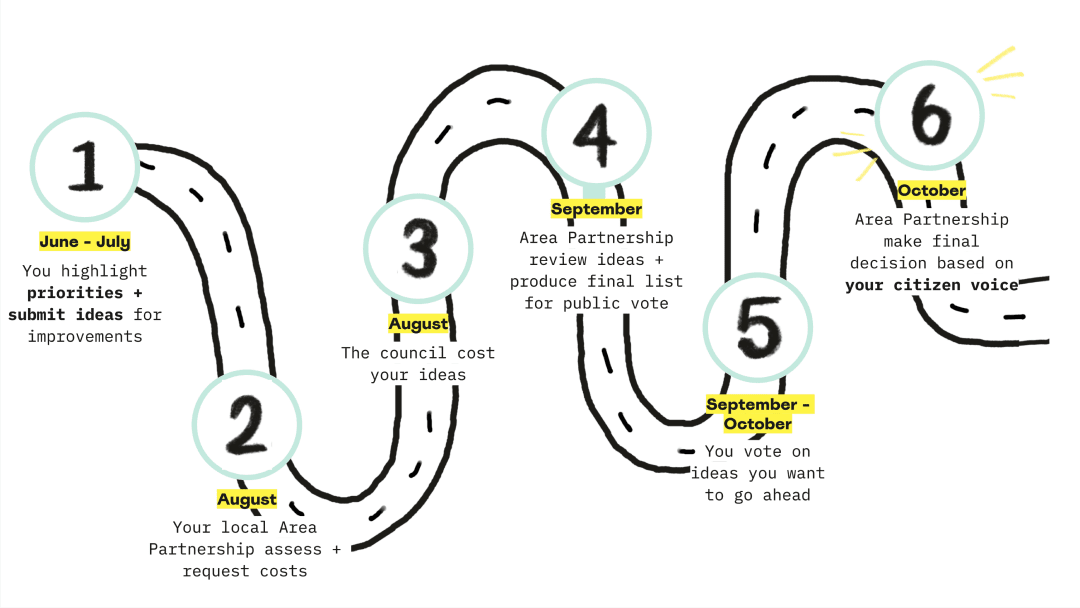Your Citizen Voice
Calton
A model for participation in local neighbourhoods in Glasgow

19 ideas funded in Calton with Your Citizen Voice!
We're making decisions on how the Neighbourhood Infrastructure Improvement Fund is spent based on the opinions of as many local people as possible.
We asked you...
How should we spend £1 million in Calton?
160 new ideas were submitted and 3 of the most common ideas were...
15% ideas were about...
Improving or creating community facilities, centres, sports and leisure facilities
14% ideas were about...
Making the crossings and pavements safer and accessible for all
13% ideas were about...
Improving or creating community gardens, green spaces and maintenance
We asked you...
What are your priorities?
54% said...
Improve open spaces
42% said...
Improve condition of roads
39% said...
Improve pavements
After six stages, the Calton Area Partnership has made a final decision on the ideas which will be funded...
24 ideas have been funded in Calton with Your Citizen Voice!
Let's break it down...
Improving Open Spaces
4 ideas funded
£140,500
Improving Condition of Roads
1 idea funded
£132,000
Improving Pavements
7 ideas funded
£88,000
Improving Road Safety
3 ideas funded
£4,500
Improving Drainage Systems
3 ideas funded
£1,500
Improving Street Lighting
1 idea funded
£500
Improving Street Furniture
1 idea funded
£500
What about the rest of the money?
After discussion, Calton's Area Partnership have set aside £100,000 to account for inflation, any excess left will be set aside for community funding.
12 ideas have still to be fully costed, £290,858 has been allocated for this.
How was the spending of the fund agreed?
We looked at the ideas that received the most votes per 'neighbourhood' and allocated the funding to the top ideas in each neighbourhood.
We portioned the number of ideas as equally as possible between areas. We did this because shortlisting the most voted ideas regardless of their locations would have left areas with no ideas being funded. This wouldn't benefit all neighbourhoods across the ward equitably and didn't account for disparities in participation.
What about the ideas that are not funded?
Below are the ideas that were not funded as a part of the Neighbourhood Infrastructure Improvement Fund. Either they didn't fit the criteria for the fund, or they were not selected to take to the next stage by relevant council services.
You can read about the ideas that didn't make it here.
What's good about this?
This ensures all areas benefit from the fund and represent citizens' votes as the most popular ideas per area will go through.
The gap in participation during phase 1 and the various assessment phases means some areas didn't get any ideas shortlisted for public voting. If they did, some of the ideas didn't get above 60% of approval.
To mitigate this, we set a portion of the fund aside. This can then be used to engage with specific groups like young people or with specific areas like Barrowfield. We did this by removing one idea for roads costed at £205,700 and one idea in Gallowgate that only received 58% of approval.
What could be better?
Less ideas can be progressed during this phase, and undertaking further engagements means current ideas voted on will potentially be disregarded.
To ensure the un-costed shortlisted ideas can be delivered, we need to allocate them a portion of the fund (£282,083).
This means, only £250.000 are set aside for future engagements and ideas.
One of the two ideas removed was about resurfacing and fixing Springfield Road which is highly used and covers a number of areas in Calton.

Citizen power in Glasgow
The Centre for Civic Innovation are building a network of designers and solvers across the city to enthuse and empower citizens. Combining creative and inclusive approaches, place-making principles, design thinking, research, storytelling and data science to understand and help solve complex problems - difficult to articulate, challenging to solve and have no single solution.
Your Citizen Voice has been integral to discovering the ways that citizens want to be involved in local decision-making and to what extent, we'll continue to build on what we've learned throughout this process, incorporate it into our work, in order to create the city, we all want to live in, we need to enable and trust communities to imagine the future they want to see.

This is local democracy in action and putting people at the heart of the city government’s decision-making in our communities.
Hundreds of ideas on local improvements were submitted and I am delighted that we will be taking forward several of them which will see significant upgrades to infrastructure including roads, pavements, street furniture, and open spaces.
City Convener for Neighbourhoods, Assets and Services